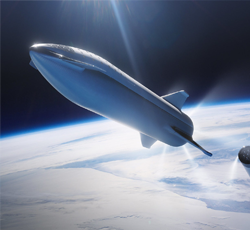
Trump and Musk's Planned Mission to Mars Could Actually Happen, Experts Say
- by Newsweek
- Apr 02, 2025
- 0 Comments
- 0 Likes Flag 0 Of 5

news article
Based on facts, either observed and verified firsthand by the reporter, or reported and verified from knowledgeable sources.
Share Aubrey Gemignani/NASA/Getty
SpaceX's Starship system, the most powerful launch vehicle ever developed, can carry up to 150 metric tons of payload while remaining fully reusable. The rocket booster, known as Super Heavy, features 33 of the company's Raptor engines, which utilize cooled liquid methane and liquid oxygen. The cumulative cost of a Mars mission, including test flights and associated infrastructure, could approach $1 trillion, Impey and Pitts estimated.
"It's hundreds of billions for sure," Impey said.
The 69-year-old astronomer and author of Beyond: Our Future in Space said he doesn't expect to see the "extremely high-risk mission" completed during his lifetime and questioned whether the enormous investment is justified.
"Musk is, of course, at least honest about his almost deeply science fiction-level motivation," Impey said. "He thinks we're just doomed on Earth and need to be a multiplanetary species, and Mars is the next potential place we can go. He's taking this very long, science fictional view of going to Mars—I get that. But that's not going to bring a lot of other people on board, that's not going to convince governments to spend vast amounts of money on it."
This image of the International Space Station (ISS) was photographed by one of the crewmembers of the STS-105 mission from the Shuttle Orbiter Discovery after separating from the ISS.
This image of the International Space Station (ISS) was photographed by one of the crewmembers of the STS-105 mission from the Shuttle Orbiter Discovery after separating from the ISS.
NASA/MSFC
NASA spokesperson Cheryl Warner said the agency works with partners like SpaceX to build an economy in low Earth orbit to take "our next giant leaps in exploration" of the moon and Mars.
"To date, NASA invested more than $15 billion in SpaceX for its work under numerous agency contracts, including commercial resupply and crew transportation services to and from the International Space Station, science launch services, development of a human landing system to support our crewed return to the Moon under the Artemis campaign, and more," Warner told Newsweek in a statement.
Boeing, the lead contractor for core stages of NASA's super heavy-lift rocket, the Space Launch System, lists 2035 on its website as a potential "arrival" date for humans on Mars. But the aviation giant mired in delays and cost overruns warned in early February that as many as 400 people could be laid off from its SLS team due to revisions to the Artemis program—casting some doubt on the mission to eventually return to the moon.
Can We Overcome All the Safety Hazards to Get to Mars?
Former NASA astronaut Jeffrey Hoffman, who has logged more than 1,200 hours in space during five flights, said he believes Starship will someday be capable of completing a round-trip Mars mission, but referenced recent setbacks.
"SpaceX has never done anything on the schedule that they originally claim," Hoffman told Newsweek. "But eventually, they get it done."
Still, things go wrong in space, Hoffman said, citing the ISS, which is scheduled to be decommissioned in 2030. "When something breaks on the space station, you have the possibility of taking spare parts up from Earth," Hoffman said. "But once you're on your way to Mars, you're on your own. So just the reliability of all the systems has to be significantly higher than what we have today."
Hoffman suggested an initial journey to Mars might entail more than one Starship or another spacecraft to provide a haven in case of emergency.
Artemis launch team members listen to Artemis II astronauts during their visit to Firing Room 1 in the Launch Control Center at NASA’s Kennedy Space Center in Florida on Aug. 7, 2023.
Artemis launch team members listen to Artemis II astronauts during their visit to Firing Room 1 in the Launch Control Center at NASA’s Kennedy Space Center in Florida on Aug. 7, 2023.
NASA/Kim Shiflett
"The one thing you cannot do is take a huge number of spare parts along," he said. "For every kilogram [2.2 pounds] you want to get to the surface of Mars, you've got to put about 15 kilograms [33 pounds] into Earth orbit, so that's a lot of launches. Mass is absolutely critical."
NASA is currently working to develop exercise equipment for astronauts to potentially use on Mars to keep them healthy for long durations, representing another challenge with travel there, Hoffman said.
"So, we've got the exercise problem, we've got the reliability problem and then of course there's the radiation, which is still, I'd have to say, really an unsolved problem," he said. "If we don't get a major solar flare on the way to Mars, it's something that the crew can probably tolerate."
Assuming astronauts safely reach Mars, they could potentially produce oxygen on the planet by taking carbon dioxide from the atmosphere and electrolyzing it to isolate the oxygen atoms, Hoffman said.
SpaceX Starship rocket takes off during it's sixth test flight on November 19, 2024 in Brownsville, Texas.
SpaceX Starship rocket takes off during it's sixth test flight on November 19, 2024 in Brownsville, Texas.
Brandon Bell/Getty
The critical task of producing propellant on Mars for a return trip to Earth would also require huge amounts of electricity, roughly 25 to 30 kilowatts, likely requiring nuclear power plants, Hoffman said.
"We have yet to have nuclear reactors on the surface of the moon or Mars," he said. "NASA is working on that because I think everybody realizes that humans living on other planetary surfaces are going to need 30 to 40 kilowatts to run their habitats, to make oxygen and so on, but we don't have that. So that's a big problem."
Hoffman said the pledge to put an American flag on Mars, and "even far beyond" as Trump has vowed, appears disjointed.
"It's really stretching NASA just to get back to the moon," he said. "I think we're doing things the right way from that point of view. There's an awful lot of new technology and procedures that have to be tested out and I'd like to see successful lunar operations before we commit a crew to go to Mars."
President George H. W. Bush first announced America's aspirations for Mars on July 20, 1989, while marking the 20th anniversary of the Apollo 11 lunar landing. Bush called for the construction of a space station and to send astronauts back to the moon—and ultimately a "manned mission" to Mars.
NASA astronaut Sunita Williams speaks virtually from the International Space Station to attendees at a reception in celebration of Diwali, the Hindu festival of lights, in the East Room of the White House in Washington,...
NASA astronaut Sunita Williams speaks virtually from the International Space Station to attendees at a reception in celebration of Diwali, the Hindu festival of lights, in the East Room of the White House in Washington, DC, October 28, 2024.
More
Please first to comment
Related Post
Stay Connected
Tweets by elonmuskTo get the latest tweets please make sure you are logged in on X on this browser.
Sponsored
Popular Post
Sam Altman's OpenAI Takes On Elon Musk's Grok in AI Chess Tournament Final - Who Won?
28 ViewsAug 09 ,2025






 Energy
Energy


















